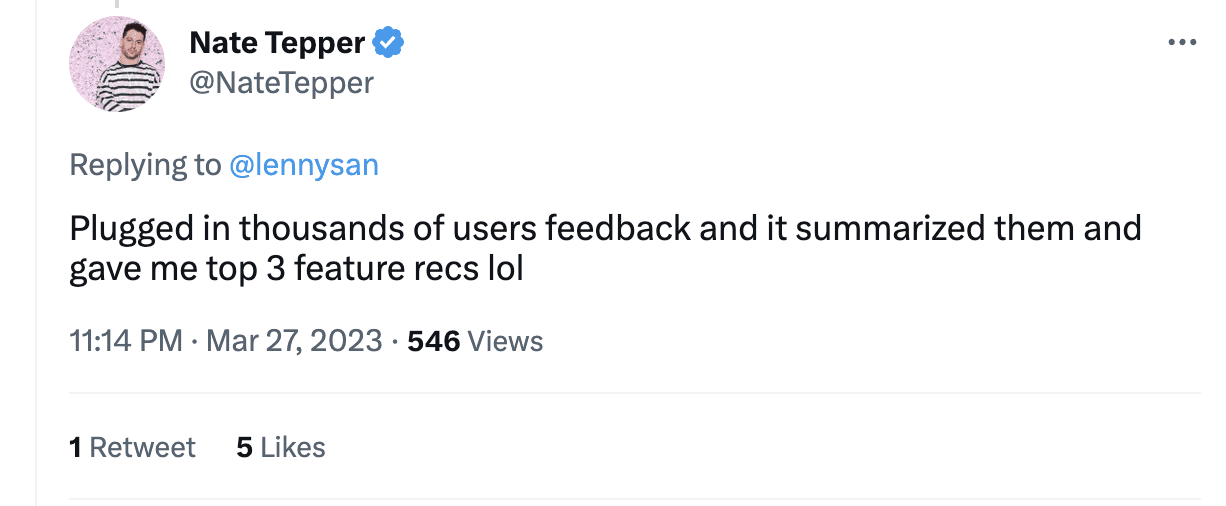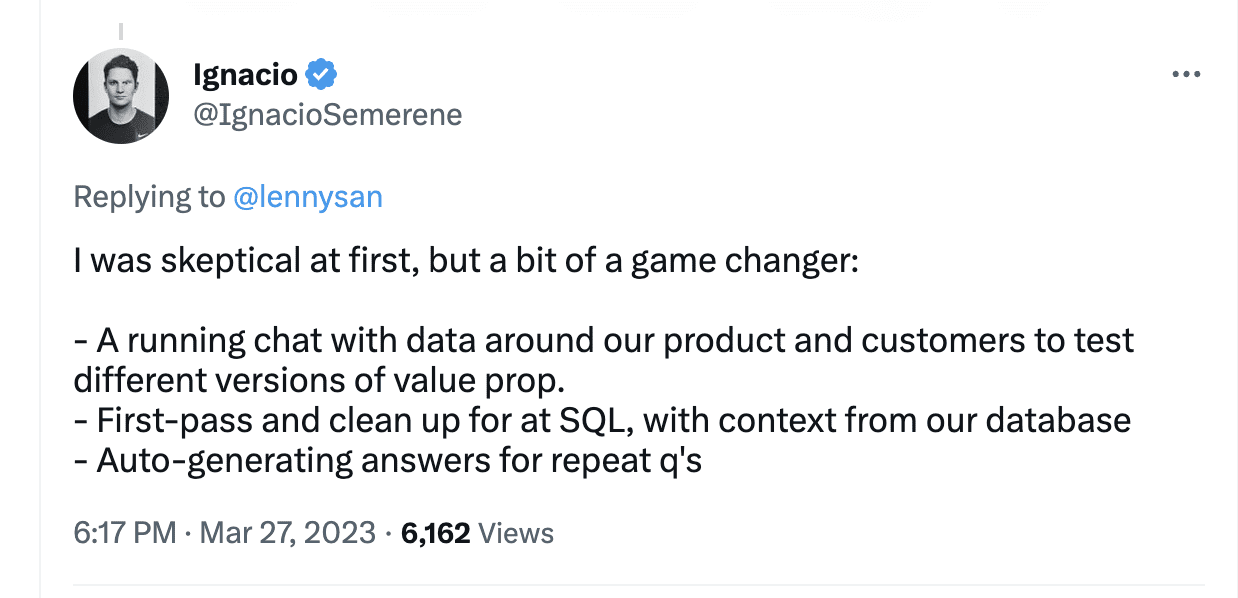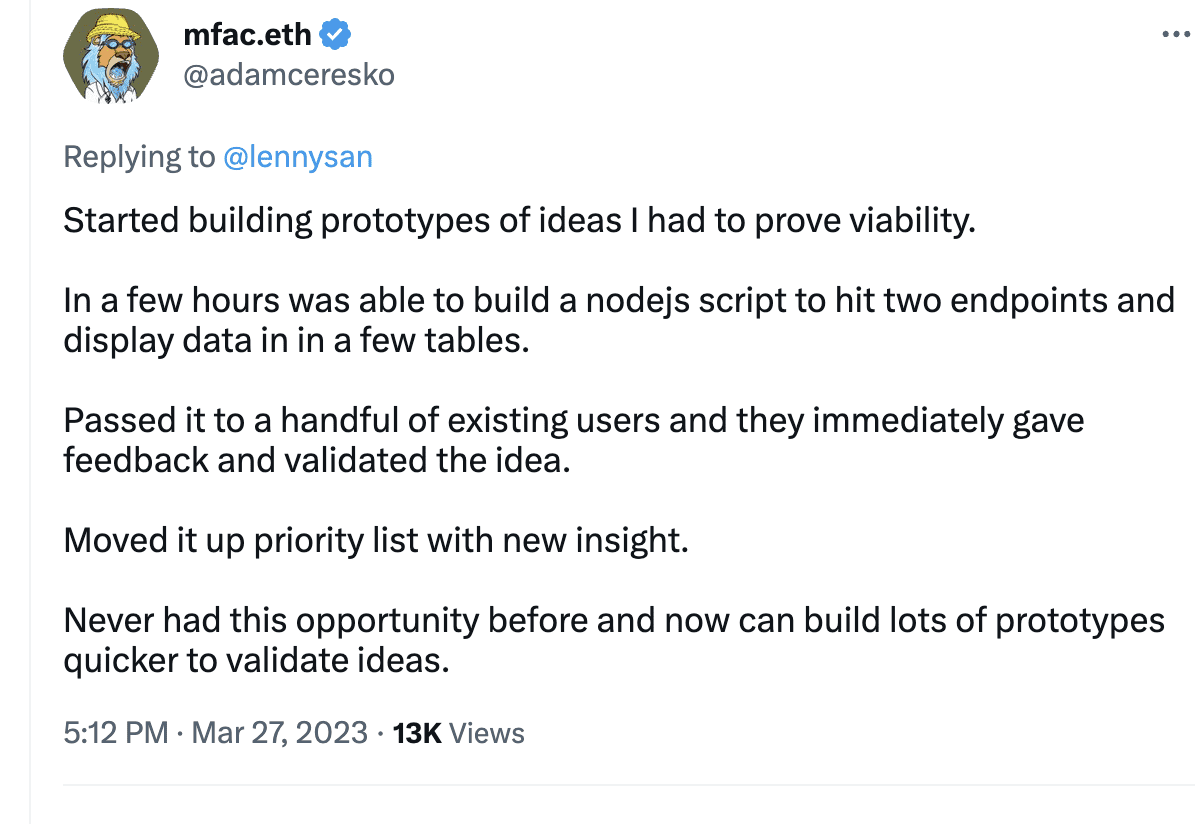I choose a lazy person to do a hard job. Because a lazy person will find an easy way to do it.
Bill Gates Tweet
Wise words from Bill Gates, However, nowadays, instead of relying on a lazy person, you can turn to Chat GPT, our best friend, as GPT-3 and now GPT-4 have become more powerful and accessible.
This way, product managers can use natural language processing (NLP) tools to automate tedious tasks. While some may argue that using AI tools is lazy, we believe it is a smart way to save time and improve efficiency. Plus, why waste time doing something yourself when you can sit back and let the AI do the heavy lifting? Plus, let’s be real; we’re all lazy deep down, right? Just ask Tom in an email 🙂
@tldv.io Thank goodness for AI (credit to @marketoonist on IG) #ai #artificialintelligence #chatgpt #chatgpt4
♬ original sound - tldv.io - AI Meeting Recorder
But what is a product manager?
In its simplest form, a product manager defines, launches, and manages successful products. It is a cross-functional role that involves coordinating efforts between engineering, design, marketing, and other teams to ensure a product is successfully built and launched.
Product management oversees user research, product strategy, customer feedback analysis, and user story creation. It is essential to a successful product launch, and a solid foundation for each step can create the best products that solve your target customers’ most prominent pain points.
So what's that got to do with AI?

Using AI in an impactful way allows product managers to focus on higher-level tasks, such as strategy and vision, while delegating more repetitive tasks to AI tools. This can lead to better decision-making and, ultimately, better products.
There is a multitude of ways that Chat GPT and GPT-4 can help product managers. These range from small tasks, such as getting summaries of customer feedback, to more complex projects, like creating marketing copy or generating user stories automatically. The world is your oyster when it comes to Chat GPT and GPT-4.
Product management has always been a human-driven task. Humans create processes to ask humans about human thoughts and feelings. Although much of the collected data can be presented quantitatively, emotion heavily influences it. This can be emotions such as frustration, anger, joy, and despondency. And while AI has never really been the best at reading emotions in the past, as NLP tools become increasingly sophisticated, it’s starting to catch up.

One huge help is that Chat GPT and GPT-4 can be used to create user stories. It can help product managers start the process by taking a customer’s problem and creating a storyboard outlining all the steps required to solve it. This could be immensely helpful in kick-starting processes that take too long or require too many resources for a human to do efficiently.
AI can also help with customer feedback analysis. Product managers can ask GPT-4 to summarize customer feedback to get a more detailed and insightful understanding of what customers say about the product. This could help them quickly identify areas where they need to focus development efforts or suggest changes to make the product more successful.
AI can help product managers analyze data from various sources, such as apps and websites, to uncover insights humans may overlook. This would help them identify areas of improvement in their products and uncover opportunities for new product initiatives.
Developing ChatGPT Prompts For Product Managers
As we have mentioned, there are limitless ways that product managers can use Chat GPT to help with the day-to-day and bigger-picture tasks of the product. But how do you actually get it to do these things? What things do you need to type in?
You can’t just shout at the computer and expect it to come up with gold.

It’s all about crafting the perfect prompt. Think of it like talking to a toddler (or a really smart dog).
You need to be clear, concise, and specific. Ask the right questions, and you’ll get the answers you need. Ask the wrong ones, and you’ll end up with a bunch of gibberish.
First things first, while being methodical and thoughtful can be incredibly helpful when trying to come up with prompts, it is definitely a case of trial and error.
Learning to use AI successfully, whatever your job role or goals, is a new skill. Like the art of conversation, you must lay out WHAT you want and HOW you want it. You might even need to give a hint as to WHY to get the “right” kind of output.

So, before diving into how to formulate a prompt, it is essential to understand what exactly you are asking your AI assistant. Prompts should be designed around questions the user’s team wants answered or actions they expect the assistant to perform.
A clear understanding of the desired information or task helps structure the prompt appropriately.
- When creating a prompt, several things must be considered:
- The goal of the task
- The type of data
- The appropriate information retrieval method
Phrasing can yield different outcomes.
So, for example, “What are the key features that my product should have?” vs. “What are the most important problems that my product should solve?”
While these questions pertain to product development, they have two different objectives. The first question asks for a list of features that could be included in your product, while the second asks for insight into the core problems or pain points your product should address. Depending on the output from ChatGPT, you could end up with a list of features that may not solve the key problems your customers face, or vice versa.
Using Templates Or Frameworks
We love a framework in Product! If you have an idea or process of how to craft a prompt, it can help guide the structure and wording of the prompt to ensure it aligns with the desired outcome.
For example, if you’re using Chat GPT for customer feedback analysis, a template could be:
“When analyzing customer feedback for [product/service], please provide a summary of the most common complaints and suggestions for improvement.”
This prompt is clear about the goal of the task, the type of data (customer feedback), and the appropriate method of information retrieval (a summary of common complaints and suggestions).
Another critical aspect of crafting effective prompts is considering the task context.
For example, suppose you’re using Chat GPT to generate user stories. In that case, you should provide context around the customer problem to ensure the AI assistant understands the task entirely. This could look like this:
“Based on the customer feedback we’ve received regarding [problem], please create a user story that outlines the steps required to solve this problem.”
By providing context around the problem, the prompt is more specific and focused on the desired outcome.
Ways Product Managers Are Already Using ChatCPT, GPT-3 & GPT-4

With ChatGPT, you can sift through thousands of users’ feedback in just a few minutes. That’s right, you heard it here first!
While taking a second look at the feedback manually is always recommended, especially if it contains sensitive information, ChatGPT can give you a quick and dirty high-level summary of the emerging key trends and patterns. This makes it easy to double down on specific examples and drives your point home.
Why bother with manual feedback analysis when ChatGPT can do the grunt work for you? After all, time is money, and you could be spending yours on more important things!
Great prompts for this would be:
- What are users’ most common themes or topics in their responses?
- Are there any patterns or trends in how users respond to certain questions or topics?
- What are the key opinions or attitudes expressed by users in their responses?
- How do users’ responses vary based on age, gender, location, or other demographic information?
- Can any surprising or unexpected insights be gleaned from analyzing users’ responses?

Some users are using GPT-3 and AI to supercharge any tricky (and by that, we mean BORING) legal issues.
While it cannot replace actual legal advice, AI can provide a comprehensive summary of the legal requirements in some instances. In the future, AI may be used to help detect any potential gaps in compliance when designing and creating products for customers. By leveraging the power of AI in this way, product managers can quickly and efficiently surface any legal issues that need to be addressed without having to spend time reading through complex documents or researching laws.
To leverage this skill, why not try these prompts (but ensure that you seek confirmation from a legal professional):
- You are a product manager at [company]. How does GDPR impact our product development process, and what steps can we take to ensure compliance?
- Our product collects user data for [purpose]. Is this data collection GDPR compliant? If not, what changes do we need to make?
- A customer has requested that we delete all their personal data. How do we ensure GDPR compliance while fulfilling this request?
- We are considering using a third-party service that processes user data. Before using this service, what GDPR requirements should we look for in a data processing agreement?
- Our marketing team wants to send targeted emails based on user data. Is this email GDPR compliant, and what steps must we take to ensure compliance?

ChatGPT and AI can help create a “team” to make you look like a rockstar!
AI-generated ideas for new features and approaches are just the beginning if you are a solo bootstrapper like this user. Need help with design documentation? ChatGPT can help with that too! Say goodbye to inconsistencies in your branding and design language – with the power of AI, you’ll be streamlining your design process like a pro in no time. So what are you waiting for? Let ChatGPT and AI take your business to the next level!
If you are on your own (or can’t be bothered to ask your team for help right now), try these prompts:
- What AI-powered features or capabilities does ChatGPT offer that can help me improve my design process or create more engaging user experiences?
- How can ChatGPT’s language capabilities be leveraged to create consistent branding and messaging across all my products or services?
- Generate new design ideas or concepts that I may not have considered before. What are some best practices for doing so?
- What are some successful examples of ChatGPT being used to improve user engagement and satisfaction, and how can I learn from their approach?
- How can I use ChatGPT to analyze user feedback and identify potential areas for improvement in my design, and what are some tools or techniques I can use to implement these changes?

Well, well, look who’s finally come to terms with the power of AI! This user went from skeptic to believer, and it’s a good thing too.
AI can be a lifesaver for your business. Keeping your customers happy and engaged is vital; one way to do that is through a good old-fashioned chat. But why stop there? Get your database in order with some sweet SQL scripts, and you’ll analyze customer data like a boss. And who needs human customer support when you can have a chatbot auto-generating answers faster than you can say “artificial intelligence”? So take a page from this user’s book and let AI work magic. Your team will thank you for it!

Creating products can be incredibly expensive.
Researching, designing, developing, and bringing a product to market takes time and money. But what if you could get a quick answer on viability without the hassle? That’s where AI comes in—AI-powered tools like ChatGPT to help with prototyping. ChatGPT can quickly scan existing products and find similarities, offer insights into potential customer interests, and suggest feature ideas. It’s like having a team of experts in your pocket! And when it comes to cost-effectiveness, you can’t beat the data-driven decision-making that AI provides.

Even on the sales side of things, product managers can rope in AI to help. This user pastes in data and then asks hypotheticals about how many leads are needed to achieve a particular conversation rate. This level of insight allows you to look at market trends, previous performance, and even forecasts based on your sales staff’s performance. There are even tools out there using GPT to help you identify potential buyers and the best time to reach out, make targeted offers or discounts, and even set up automated follow-up emails for those who don’t respond — all without having to lift a finger. So why wait? Let AI accelerate your sales process and gain a competitive edge!
Here are some prompts to help product managers become fortune-telling sales types:
- What customer behaviors or actions have been observed to correlate with increased sales?
- What is the average order value for our top-selling products, and how can we leverage this information to optimize revenue?
- Based on the data, which products are underperforming, and what changes can we make to improve their performance?
- How can we improve our overall conversion rate based on this data analysis, and what specific actions can we take to achieve this goal?
- What other data sources can we leverage to gain additional insights into customer behavior and preferences, and how can we use this information to inform product development and marketing strategies?

Using AI can help create UX research questionnaires by analyzing existing studies and identifying common questions and themes, which can then be stored in a UX research repository for future reference. By leveraging AI, you can create standard questions that can be used as a starting point for new questionnaires and use natural language generation to generate personalized questions and prompts based on user data. Additionally, machine learning algorithms can be used to improve the questionnaire over time by learning from user feedback. Also, if you are conducting user meetings over video chat for the questionnaires, then using an AI meeting assistant can add insight to the responses.
To create effective UX research questionnaires, here are five helpful prompts:
- Can you suggest some ideas for questions to include in a user research questionnaire for product development?
- How can I structure my user research questionnaire to minimize bias and ensure the best impact?
- Who should be my target audience for the user research questionnaire, and how can I tailor my questions to understand their needs and preferences best?
- What are some common biases that can affect user research results, and how can I design my questionnaire to reduce or eliminate these biases?
- What are the different types of questions I can include in my user research questionnaire, and when should I use each type?
Negatives & Ethical Issues of Using AI & ChatGPT for Product Managers
Sorry! It can’t be all sunshine and roses when it comes to AI, even if it’s a massively helpful tool for product managers. It does have some drawbacks.
Bias

Yeah, computer intelligence can be a bit bigoted. OK, maybe not that kind of bias. AI systems are only as unbiased as the data they are trained on. If the data used to train a product management AI system is biased, it can lead to discriminatory outcomes. For example, an AI-driven product management tool trained on data that underrepresents a certain demographic might result in products not optimized for that demographic.
Limited Creativity
We’re impressed, but sometimes the creativity is a bit like that drawing of a cat your nephew did for you aged 4. You smile and are impressed they can hold a crayon, but it’s not winning any Hugo Boss Prizes.
AI systems are excellent at generating ideas and solutions based on existing data but are limited in their ability to create entirely new ideas. A product manager relying solely on AI-driven tools might miss out on innovative and groundbreaking ideas that only human creativity can provide.
Lack of Context
Ever feel like you only had about 50% of the conversation, and you look like a fool when you try to joint in?
AI only knows what it knows and will rely on data to make decisions. This means that they can struggle to account for the broader context of a situation. For example, an AI-powered product management tool might suggest a price increase for a product without considering the potential impact on customer loyalty or the current economic situation of that target group without access to that data.
Overreliance on AI

Look, we’re not saying you don’t know how to do your job, but… when was the last time you wrote a document without using spell check? Or wrote a text without autosuggest? Yeah. Technology makes life easier, but it does mean that we can become a touch reliant on it.
Relying too heavily on AI-driven tools can lead to complacency and a lack of critical thinking. A product manager might blindly follow the suggestions of an AI system without fully understanding the underlying assumptions or implications.
Lack Of Transparency
Code, programming, secret sauce. When people use AI and ChatGPT, they marvel at how it works without knowing HOW it works.
AI systems are essentially black boxes, meaning it is difficult or impossible to understand how the system arrives at its decisions. This lack of transparency can be problematic from a regulatory standpoint, making it difficult for product managers to fully trust the system’s recommendations.
It Can Make Mistakes

To err is human; while AI isn’t human, it IS designed by one. And that comes with biases, but it can make mistakes. While driven by data, data doesn’t always get nuance. For example, an AI system might recommend a product feature that is technically feasible but not desirable to customers. Equally, it might suggest cost-cutting measures which can compromise the quality of the product.
The best case for this is to use it freely but implement it sparingly with additional research (which you SHOULD be doing anyway!)
GPT For Product Managers Is The Future
Product managers, you absolutely 100% need to be using AI in some way, shape, or form. Even if you think it’s icky, it IS the future and the culture. You will get left behind if you don’t (or you can call yourself an artisanal product manager). While you must be aware of the potential drawbacks and exercise caution in using them, AI-driven product management tools can be invaluable.
Much like being a User Researcher requires specialist knowledge of how to ask questions, what questions to ask, and more, a product manager must learn how to ask AI to do the right thing.
Get to know Chat GPT and other GPT-3 and GPT-4 driven tools. See how it works and how you can interact with it. The more you play and learn, the more you bring your knowledge and skillset to a tool, and the better it will get.

And let’s face it, as a product manager, you’re already juggling a million tasks, putting out fires left and right, and trying to keep everyone happy. Why not let AI lend a helping hand? It’s like having your personal assistant without the snarky attitude and constant need for bathroom breaks.
We know that AI-driven product management tools can analyze vast amounts of data in seconds, giving you insights that would take a team of analysts days or weeks to uncover. Plus, they don’t get tired or make mistakes due to human error. With AI on your side, you can make data-driven decisions faster than ever before and be confident that you’re making the best choices for your product.
But wait, there’s more! AI can even help you predict future trends and customer behavior, giving you a leg up on the competition. It’s like having your own oracle without all the incense and tarot cards. And with the ability to automate repetitive tasks and workflows, you’ll have more time to focus on the things that matter, like taking a nap under your desk or binge-watching the latest Netflix series.
So, product managers, embrace the power of AI! It’s not just the future; it’s the present. And let’s be honest, who wouldn’t want a personal assistant that never sleeps, never complains, and never steals your lunch from the office fridge?
And, if you’re looking dor another awesome AI-driven tool perfect for product managers. Then tl;dv can also help out in that respect. Record every user interview, store, highlight and analyze every single insight. Happy days!





